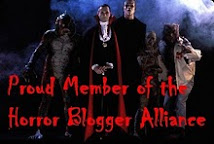When it comes to making independent b-movies, there's no bigger name than Roger Corman. Between 1955 and 1971, Corman directed nearly 50 feature films, and was notorious for quickly putting together a product that could thrill drive-in audiences. These films included many adaptations of Edgar Allan Poe's work (generally with Vincent Price in the lead), sci-fi fare like Attack of the Crab Monsters and She Gods of Shark Reef, and even crime films, westerns, and war movies. He left the directors chair to produce dozens more films in the 1970s and 1980s, but made a return one more time - 1990's Frankenstein Unbound.
I don't know why Corman would agree to make this, of all films, after avoiding the director credit for 19 years, but I can theorize. Part of me wants to say I understand his reasoning. The Frankenstein legend, as originally written by Mary Wollstonecraft Shelley, has been my favorite book for many years. I've read it multiple times, and have come to the realization through my cinematic pursuits that the story as she told it is something no one has really been able to capture that story as it was intended. From watching Frankenstein Unbound, it appears to me that Corman's intention was not to capture the young Mrs. Shelley's story....but to add his own flavor to the Frankenstein legacy.
Or, maybe he just wanted to go hang out in Italy and film a movie for fun. But I like to give more credit than is sometimes due, so I'll go with the last paragraph.
The Plot
Now, if you know anything about Frankenstein, you might be wondering why the still from the film features people sitting in a car with pods that's supposed to look futuristic even though Batman the TV series did it 25 years earlier. It's a good question, because this is not the Frankenstein you know.
In fact, our film starts in the year 2031, with scientist John Buchanan working on a new super nuclear laser weapon that could change humanity...except that it seems to have opened up a portal in the sky that no one really understands. Buchanan finds out first hand when a Genghis Khan wannabe pops out from the sky at him and some kids who were burying a bike in his yard, and finds himself sucked through the wormhole (thankfully, with his talking future car). He lands in 1817 Italy, and finds himself in the middle of the Frankenstein tale.
Buchanan thinks it's odd when he meets Dr. Frankenstein (Raul Julia), but doesn't think it's too odd. In fact, he pretty much wows Doc Frank with things like a digital wristwatch and a ballpoint pen. But when he also meets Miss Mary Wollstonecraft Godwin (Bridget Fonda), who's engaged to Lord Byron Shelley and happens to be writing a book, and he realizes he's in the middle of a real legend. And then it gets confusing.
The Good
Frankenstein Unbound is nothing if not creative. While it's not the first film to transcend time and space in regard to killers (Time After Time did it and did it right in '79), it takes an interesting turn in dealing with both the writer and the characters in separate stories. In fact, the parallel between Buchanan's interactions with each side of the story is one of the film's more interesting ideas, even if it is not fully realized in the film's short run-time. Other positives include the fact that both Hurt and Julia both put more vigor into their performances than the film is really worth, and that there's some beautiful scenery. But that's where the short list ends.
The Bad
It's hard to rip apart a film like Frankenstein Unbound, because anyone who watches it will probably jump to the "What the hell?" stage very quickly. But the biggest disappointment, as is usual with the Frankenstein tale on film, is that the real drama of Shelley's novel - the monster's search for acceptance and rage against the maker that made him hideous - is still nonexistent. The film does get into the Bride section of the story, but the monster itself (played by Nick Brimble) is not scary, interesting, or humane. The film skips over the parts of the legend in which the monster is trying to help others and trying to earn acceptance, leaving the story dull whenever his carnage occurs on or off screen.
Random Moments
- The Monster just looks silly. I'm not sure why sprockets coming out of cheeks and the forehead made sense, but that's what they went with.
- Fonda's young Mary proclaims to Buchanan, after being wooed by his 21st century awesomeness, that "Percy and Byron preach free love. I practice it." Today, there's a four letter word for that!
- Speaking of that silly monster, for some reason they decided Dr. Frankenstein would have needed to piece together eyes of three different colors to make him work to. Just look at this box cover, and marvel in the silliness.
Sometimes an idea for a movie is so bad that it almost seems good - like it's something you want to hate, but you're just too darn shocked that it exists to fully give up on it. Frankenstein Unbound fits that mold perfectly. It's utterly ridiculous, but it's got good actors hamming it up, a director that knows how to make something out of nothing, and a talking car. Can I find any reason to recommend someone watch Frankenstein Unbound? Not at all. But it's just crazy enough that I can't fully dismiss it. It happened. That's about it.
The Mike's Rating: Time Burner












